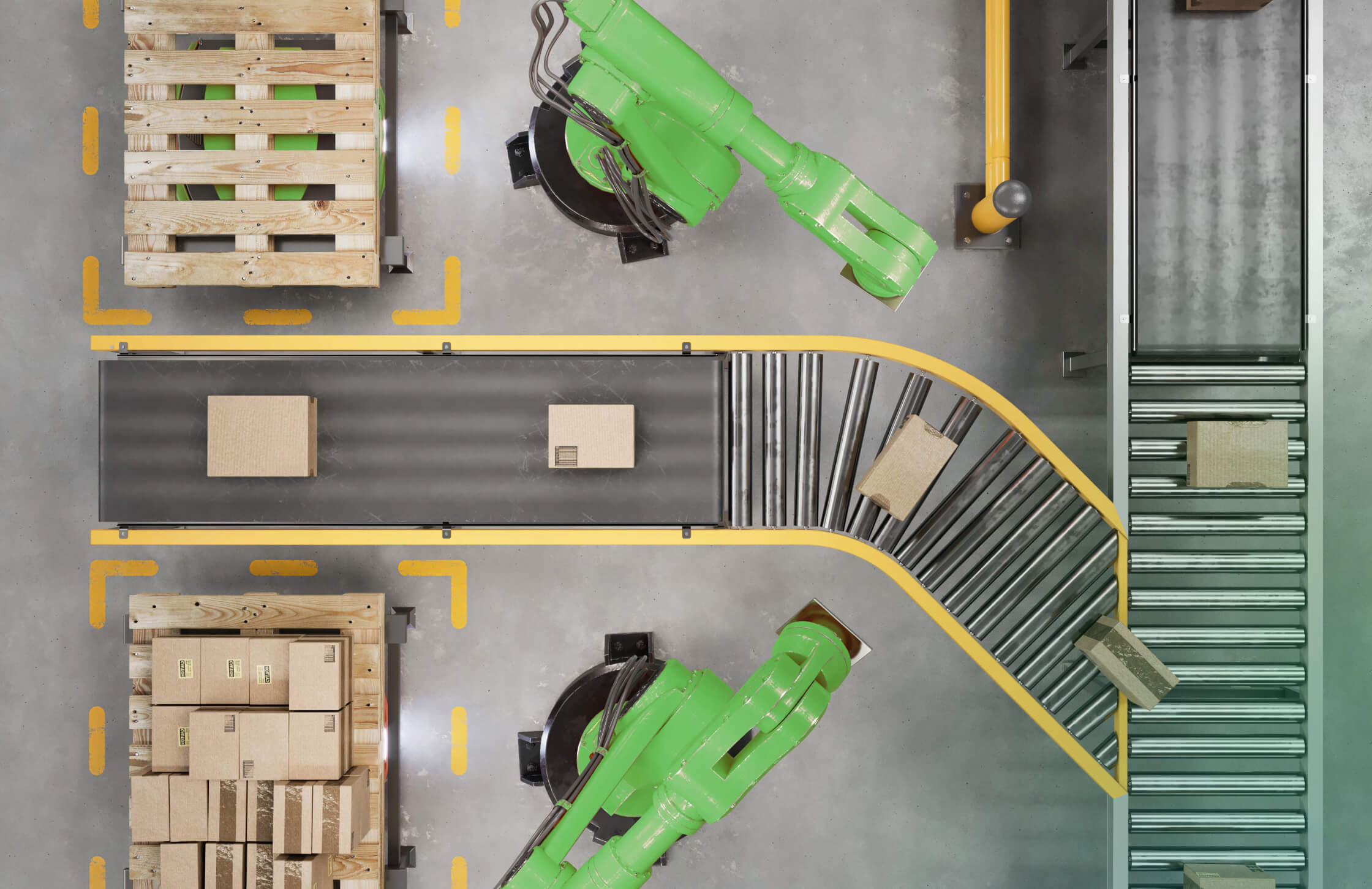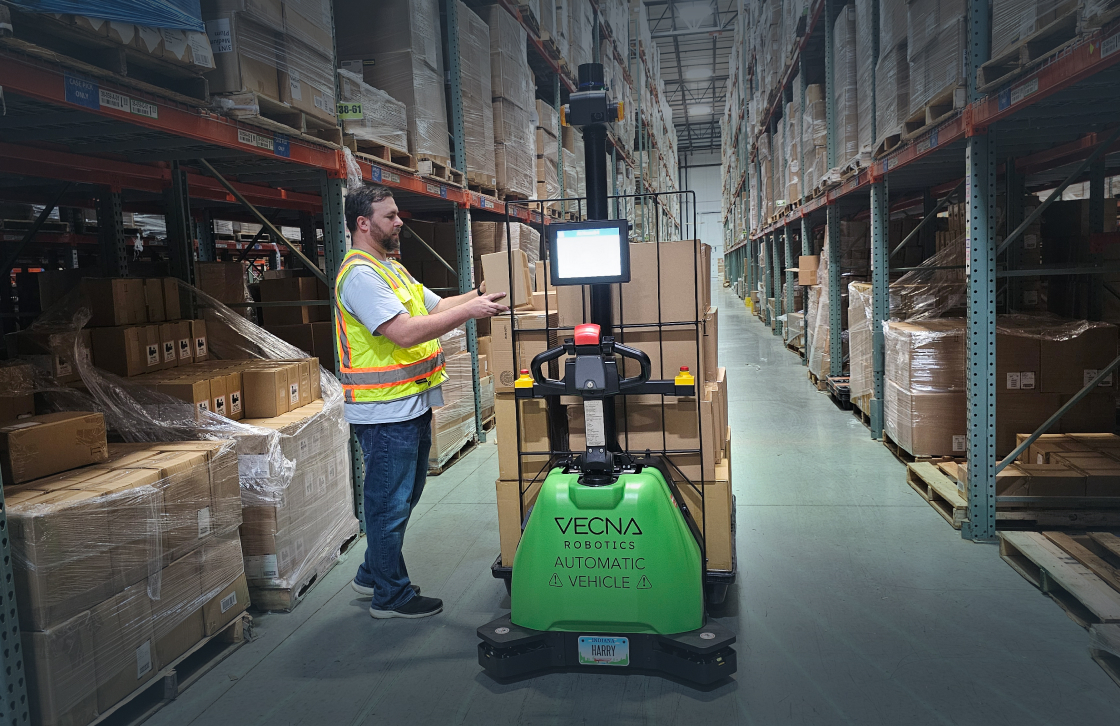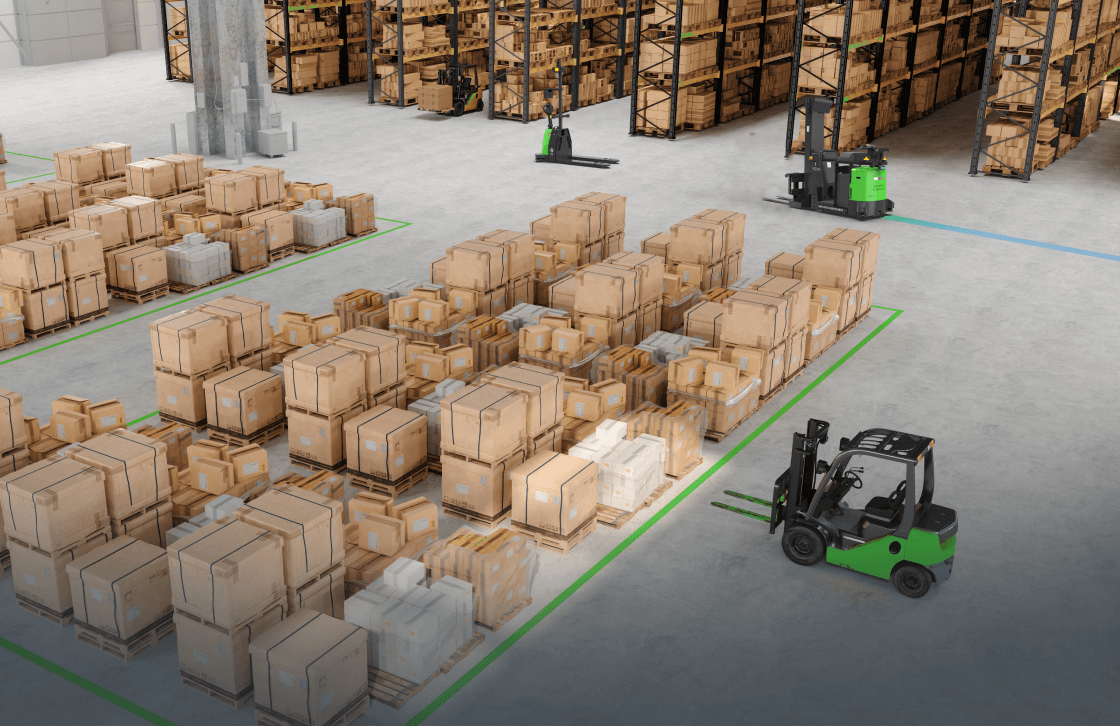What is warehouse automation?
Warehouse automation refers to the use of technology, including robotics, software, and other automated systems, to perform and manage warehouse tasks with minimal human intervention. The goal of warehouse automation is to increase efficiency, accuracy, and consistency while reducing labor costs and potential errors. It’s an essential aspect of modern supply chain management, responding to the demands for faster processing and delivery times, and plays a key role in enhancing overall productivity and competitiveness.
Types of warehouse automation technology
Material handling automation
This type of automation involves the use of machines and equipment to transport, handle, store, and keep track of materials within a warehouse. Examples include conveyor belts, automated guided vehicles (AGVs), and robotic palletizers.
Storage automation
This type of automation involves using technology to optimize the storage of materials in a warehouse. Examples include automated storage and retrieval systems (ASRS), automated stacker cranes, and pallet shuttle systems. Picking and packing automation: This type of automation involves using technology to improve the accuracy and efficiency of the picking and packing process. Examples include goods-to-person systems, pick-to-k-to-light, picking robots, and automated packaging systems.
Sortation and distribution automation
This type of automation involves the use of technology to improve the speed and accuracy of sorting and distributing materials within a warehouse. Examples include putwalls, robotic sortation systems, and cross-belt sorters.
Inventory management automation
This type of automation involves the use of technology to improve the accuracy and efficiency of inventory management. Examples include warehouse management systems (WMS), enterprise resource planning (ERP) systems, radio-frequency identification (RFID) systems, and barcode scanning systems.
8 warehouse automation trends for 2024
Artificial intelligence and machine learning
These technologies enable more accurate predictions and improved decision-making, allowing the systems to adapt to changing conditions. Specifically, they are applied to predict demand, optimize inventory, enhance decision-making processes, and enable robots to learn from their environment, leading to continuous performance improvements over time.
IoT for enhanced efficiency
The increasing deployment of Internet of Things (IoT) devices and sensors in warehouses is enhancing overall operational efficiency. These tools enable real-time monitoring and tracking of inventory, equipment performance, environmental conditions, and worker performance. By providing greater visibility across the warehouse and allowing for predictive maintenance, the integration of IoT technology contributes to a more streamlined and efficient operation.
Drones and autonomous mobile robots (AMRs)
These technologies are being used to improve the efficiency of material handling and inventory management in warehouses. Unlike traditional Automated Guided Vehicles (AGVs), AMRs have the ability to navigate autonomously and adapt to changing environments. This flexibility enables them to support various tasks within the warehouse, including picking, sorting, and transporting goods, thereby enhancing overall workflow and adaptability.
Blockchain technology
Blockchain technology offers transparency and traceability as key features, making it highly valuable in the warehouse environment. It provides a transparent and unchangeable record of transactions, creating a secure ledger for tracking the movement and status of goods. Every time an item is received, moved, picked, or shipped, a record is generated in the blockchain, granting real-time visibility to all involved parties. Additionally, the security inherent in blockchain assists in verifying product authenticity. This is vital in industries where counterfeit goods are prevalent. By documenting the entire lifecycle of a product within the blockchain, stakeholders can confirm its origin, ensuring that only genuine products are managed and dispatched.
Virtual and augmented reality
VR is utilized for training to create immersive environments that instruct warehouse staff in procedures and safety protocols, offering a hands-on experience without real-world risks. In terms of collaboration, AR is being leveraged to facilitate remote interactions, allowing experts to view what on-site personnel see and guide them through digital annotations. Moreover, AR is instrumental in the picking processes within the warehouse. It overlays digital information on physical objects, including directions to an item’s location, specifications, and picking instructions through devices like AR glasses. This application not only reduces errors but also significantly increases efficiency. Together, these technologies are transforming the way warehouses function, providing more interactive and efficient processes for both training and daily operations.
Flexible warehouse automation solutions
Autonomous Mobile Robots (AMRs) epitomize the flexibility that characterizes modern automation solutions, particularly as e-commerce and customer demands evolve. Unlike rigid systems, today’s warehouse automation solutions are becoming more adaptable, featuring flexible and modular designs. These allow warehouses to adapt swiftly to changing needs. These flexible solutions are thoughtfully crafted to integrate seamlessly with existing warehouse infrastructure, which minimizes disruption and fosters the incremental implementation of automation technologies. Furthermore, the scalability of flexible automation, with the ability to adjust up or down as required, represents a cost-effective approach, strategically aligned to meet both immediate and future operational needs.
Cobots aka collaborative mobile robots
Collaborative robots, also known as “cobots,” are engineered to operate safely alongside human workers, and their use in warehouses is on the rise. These cobots are being integrated into workflows to handle repetitive tasks, thereby improving efficiency and productivity without completely replacing the human workforce. What sets cobots apart is their ability to learn from human actions and adapt to various tasks, providing a flexible solution that combines human intelligence with robotic precision and stamina.
5G technology
The emergence of 5G networks is transforming warehouse automation systems, making them faster, more responsive, and more secure. A recent market survey commissioned by Vecna Robotics reveals that in 2023, 50% of enterprise-sized companies are investing in 5G wireless technology within their warehouses and factories. This investment underscores the value of 5G’s high-speed connectivity, which allows for the swift transmission of large data volumes, paving the way for real-time decision-making in warehouse operations. The increase in bandwidth and decrease in latency that comes with 5G also ensures uninterrupted communication between various components like automated systems, robots, sensors, and human operators. Consequently, this enhanced communication streamlines operations, leading to more synchronized and efficient workflows.
Current and future benefits of AMRs
Amidst this whirlwind of technologies and constantly evolving needs in today’s warehouses, mobile robots (also commonly referred to as autonomous mobile robots, or AMRs), have become increasingly important to the warehouse of the future. These robots are designed to move around warehouses and perform tasks such as material handling, picking, and inventory management.
Efficiency and productivity
One of the main advantages of mobile robots is their transformative ability to increase the efficiency and productivity of warehouse operations. They automate repetitive tasks such as picking and transporting goods, allowing human workers to focus on more complex duties and operate without fatigue. AMRs’ ability to determine optimized routes through real-time data analysis and adapt to obstacles ensures efficient movement within the warehouse. Capable of continuous 24/7 operation, they increase overall productivity, and their precise execution of tasks leads to improved accuracy and reduced errors. Integration with Warehouse Management Systems (WMS) aligns AMRs’ activities with real-time needs, while their scalability allows for quick adaptation to fluctuating demands. Handling potentially hazardous tasks enhances safety, and the continuous collection and analysis of data enable ongoing efficiency improvements.
Safety
Autonomous Mobile Robots significantly improve warehouse safety through various integrated features and functionalities. By handling the lifting and transportation of heavy or dangerous materials, they minimize the risk of physical strain and injury to human workers. Their ability to follow precise paths and make consistent movements reduces the likelihood of collisions and mishaps that might occur due to human error. Additionally, some AMRs are equipped with sensors and cameras for continuous monitoring of the warehouse environment, detecting potential hazards, and alerting human operators. They can also quickly adapt to changes in the environment or tasks, ensuring that they follow the safest routes and procedures, and can be programmed to adhere strictly to safety protocols.
Rapid adaptation
Another advantage of mobile robots is their remarkable ability to adapt to changing conditions within warehouse environments, setting them apart from traditional automation solutions. Through dynamic path planning, they continuously scan their surroundings to find efficient routes, rerouting in real time if obstacles are detected. Equipped with machine learning algorithms, AMRs can learn from their environment and optimize their tasks, even as conditions change. Their seamless integration with warehouse management systems (WMS) enables them to respond to real-time changes in inventory or orders, and their design allows for reprogramming or the addition of attachments to handle various tasks. AMRs are also capable of working safely alongside human workers, adjusting to their workflows, and can be scaled or reconfigured as warehouse needs evolve. These features collectively contribute to the adaptability of AMRs, making them highly responsive and versatile tools in the dynamic and complex landscape of warehouse operations.
Enhanced supply chain
Mobile robots also play a significant role in enhancing supply chain transparency and security through a combination of cutting-edge features. By leveraging real-time tracking and reporting, AMRs provide continuous visibility of inventory, contributing to transparent and accurate operations. Their ability to integrate seamlessly with Warehouse Management Systems (WMS), Enterprise Resource Planning (ERP) systems, and other tracking technologies offers a unified view of the entire supply chain, thereby enhancing transparency. Through secure communication protocols and encryption, AMRs safeguard sensitive information, adding a layer of security. They also ensure compliance with legal and industry standards, building trust within the supply chain. By minimizing human errors in inventory handling, they strengthen the integrity of the supply chain, and in industries where authentication is critical, AMRs facilitate protocols to verify product authenticity.
Addressing labor shortages, supply chain disruptions, and more
As we look toward 2025, the global warehouse automation market is poised for significant growth, with projections estimating it to reach $69 billion. This expansion is largely fueled by the pressing need to address the twin challenges of labor shortages and supply chain disruptions, alongside the ever-growing demand for products. Automation stands out as a strategic response to these challenges, with 25% of companies citing labor shortages and 22% pointing to supply chain disruptions as their primary motivations for adopting automated solutions. Notably, the impact of labor shortages is more pronounced in smaller facilities, whereas larger operations are increasingly turning to automation as a means to navigate supply chain complexities. Retail and e-commerce are among the sectors most affected, feeling the acute impact of these industry-wide challenges.
The warehousing sector finds itself at a critical juncture, grappling with a tight labor market that makes hiring and retaining skilled workers for manual tasks a considerable challenge. This is especially true for key positions like material handlers and forklift drivers, where staffing shortages are most severe, with reports indicating that 34% and 31% of warehouses, respectively, struggle to fill these vital roles. In this context, automation emerges as an indispensable solution, promising to take on repetitive and labor-intensive tasks and thus reduce the industry’s dependency on human labor. This shift is not just about addressing immediate labor shortages; it’s about building a more resilient, efficient, and cost-effective operational model that can adapt to the rising wages and evolving market demands.
The benefits of automation extend beyond mere operational efficiency. Among supply chain professionals, there’s a widespread acknowledgment of automation’s positive impact on workforce dynamics. A substantial 70% of professionals see automation as a key factor in enhancing employee retention, with over half recognizing its potential to upskill existing employees and create new opportunities within the evolving technological landscape. This perception underscores the role of automation not just as a tactical response to labor and supply chain issues, but as a strategic investment in the future of warehousing, promising a more adaptive, skilled, and satisfied workforce.
In summary, the move towards automation in the warehousing sector is a multifaceted strategy aimed at confronting and overcoming the critical challenges of labor shortages and supply chain disruptions. With its ability to enhance operational efficiency, foster workforce development, and ensure business continuity, automation stands as a cornerstone of the industry’s future, driving its growth and resilience in the face of global supply chain complexities.
How does implementation work?
The benefits of warehouse automation are widely recognized and appreciated. However, the process of successfully deploying an automated system can be complex and filled with potential pitfalls. Though each company’s path to automation will differ based on specific needs and goals, there are some universal considerations that can guide the way. By adhering to certain principles, businesses can approach automation more strategically, ensuring a smoother transition.
Phased Approach
When implementing warehouse automation, a phased approach is often the most sensible strategy. This involves breaking down the implementation into distinct stages, allowing for a more calculated and deliberate response to equipment needs at each phase. This method offers several key advantages:
By incrementally introducing automation into the workflow, businesses can begin reaping financial benefits more quickly, leading to a faster Return on Investment (ROI). This phased strategy not only allows for the avoidance of early mistakes, preventing early miscalculations from having a ripple effect on later stages, but it also ensures the retention of institutional knowledge. This retention prevents valuable insights and understanding from being lost in a hasty, broad-brush approach.
Before introducing any automation solution, it’s vital to simulate its operation. By replicating all material workflows, processes, and production configurations, businesses can ascertain if the chosen solution aligns with expectations, estimated ROI, and required KPIs. This essential pre-deployment step minimizes or even eliminates the risk of failure upon implementation, providing an additional layer of security and confidence in the transition to automation.
Employee Engagement
The attitudes and engagement of workers are crucial to the long-term success of automation. Transparency in introducing new technology to the workforce can ease fears or resistance, effectively demystifying the technology. By openly communicating about the changes and encouraging learning and understanding, employees can more readily grasp the technology, recognizing its benefits to both themselves and the organization.
Post-Deployment Support
Support following the deployment of warehouse automation is a critical aspect that must not be overlooked. Many implementation failures are attributed to inadequate post-deployment support, leading to unmet or missed expectations. Therefore, it’s imperative to ensure that the chosen vendor has a robust support program. Ideally, this should include remote assistance, enabling proactive monitoring of the robots and addressing any issues promptly.
The road to warehouse automation is neither simple nor uniform. However, by adhering to a phased implementation approach, insisting on pre-deployment simulations, engaging employees effectively, and ensuring ongoing support, businesses can navigate the path more smoothly. These guidelines not only mitigate risks but also set the stage for a more successful and rewarding automation journey, allowing companies to maximize the advantages of this transformative technology.
Choosing a warehouse automation partner
Engaging with an automation vendor requires careful analysis of several key aspects. It starts with assessing the supply chain network, from suppliers and manufacturing plants to the end customer. Understanding the network structure and pinpointing key facilities helps identify opportunities and challenges, which are essential for strategic planning. For instance, in the e-commerce sector, a network comprising mainly distribution centers might focus on enhancing downstream fulfillment efficiency. Acknowledging the ripple effects of automation, such as the need for frequent replenishment in micro-fulfillment centers, is vital for balance within the network. Overall, it’s essential to align the automation initiatives with the overall supply chain objectives by thoroughly understanding macro flows, opportunities, goals, and potential impacts of automation.
Alongside network analysis, it’s critical to understand the inventory nature. Automation solutions are categorized by their work type and payload capacity, so a grasp of the items moved, their range, and transportation methods is essential. Facilities with a wide SKU range, higher inventory, and larger space often become the primary targets for automation, and understanding daily volumes and peaks can help build operational profiles.
The next step is examining labor profiles within the network, as automation is meant to supplement labor shortages and reallocate staff to more valuable tasks. Identifying areas with high labor intensity and hard-to-replace resources, while considering turnover and fluctuation, contributes to a successful automation strategy.
Diving into the processes themselves forms the final component of the analysis. Automation focuses on use cases and workflows, and it aims to remove non-value-added tasks, guide employees, and expedite processes. Analyzing critical integrations, exceptions, and potential bottlenecks and maintaining flexibility for process changes ensure the best automation solution.
When selecting an ideal pilot site for automation, factors like multiple shift availability and the concept of “distance equals dollars” in material handling come into play. Longer travel distances and larger buildings are preferred, especially when using AGVs or AMRs. Modern infrastructure, reliable networks, clean environments, and clear travel aisles facilitate smooth integration with systems like WMS and enable robots to perform optimally.
Effectively engaging with an automation vendor requires a multifaceted approach, including a comprehensive analysis of network structure, inventory nature, labor profiles, and process intricacies. This foundation helps in crafting a tailored automation solution aligned with overall objectives. Selecting an ideal pilot site, considering factors like shift availability, space, infrastructure, and alignment with automation workflows, further sets the stage for successful automation implementation.
How to get started with warehouse automation
Warehouse automation is a rapidly evolving field, with new technologies and trends emerging all the time. By using these technologies, warehouses can improve efficiency, accuracy, and safety while reducing costs and increasing productivity. However, it is important for warehouse managers to carefully consider their specific needs and goals before investing in any particular automation solution. In particular, mobile robots like AMRs play a vital role in the warehouse of the future. They stand out not only for their ability to improve efficiency, productivity, and safety but also for their adaptability across varied operational areas. AMRs have the potential to redefine the landscape of supply chain transparency and security. Their significance is likely to grow even further as technology advances, solidifying their role as indispensable elements of successful warehouse operations. We know the strategic integration of AMRs and other cutting-edge automation solutions will continue to shape the future of the warehouse industry, weaving technological innovation into the fabric of everyday operations.
If you’re ready to improve the efficiency, accuracy, and safety of your warehouse through automation, get started by scheduling an initial assessment with a Vecna Robotics automation expert.





